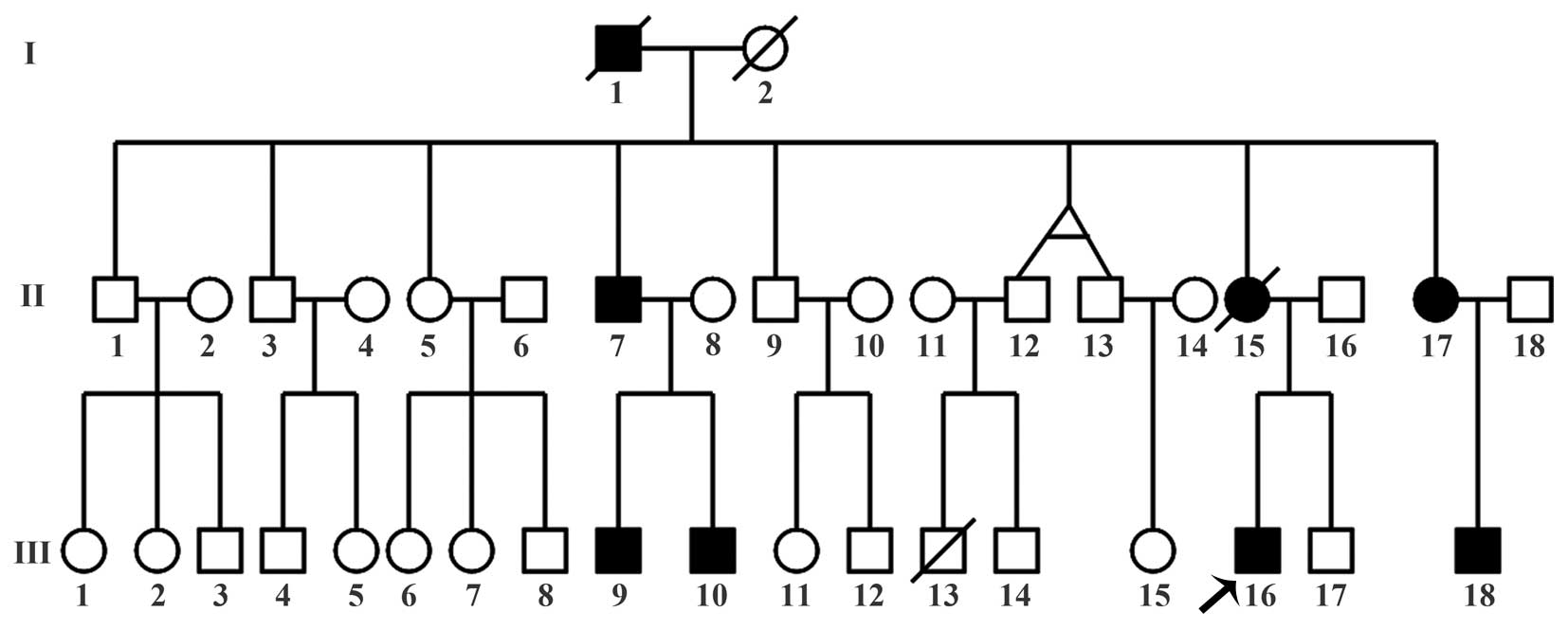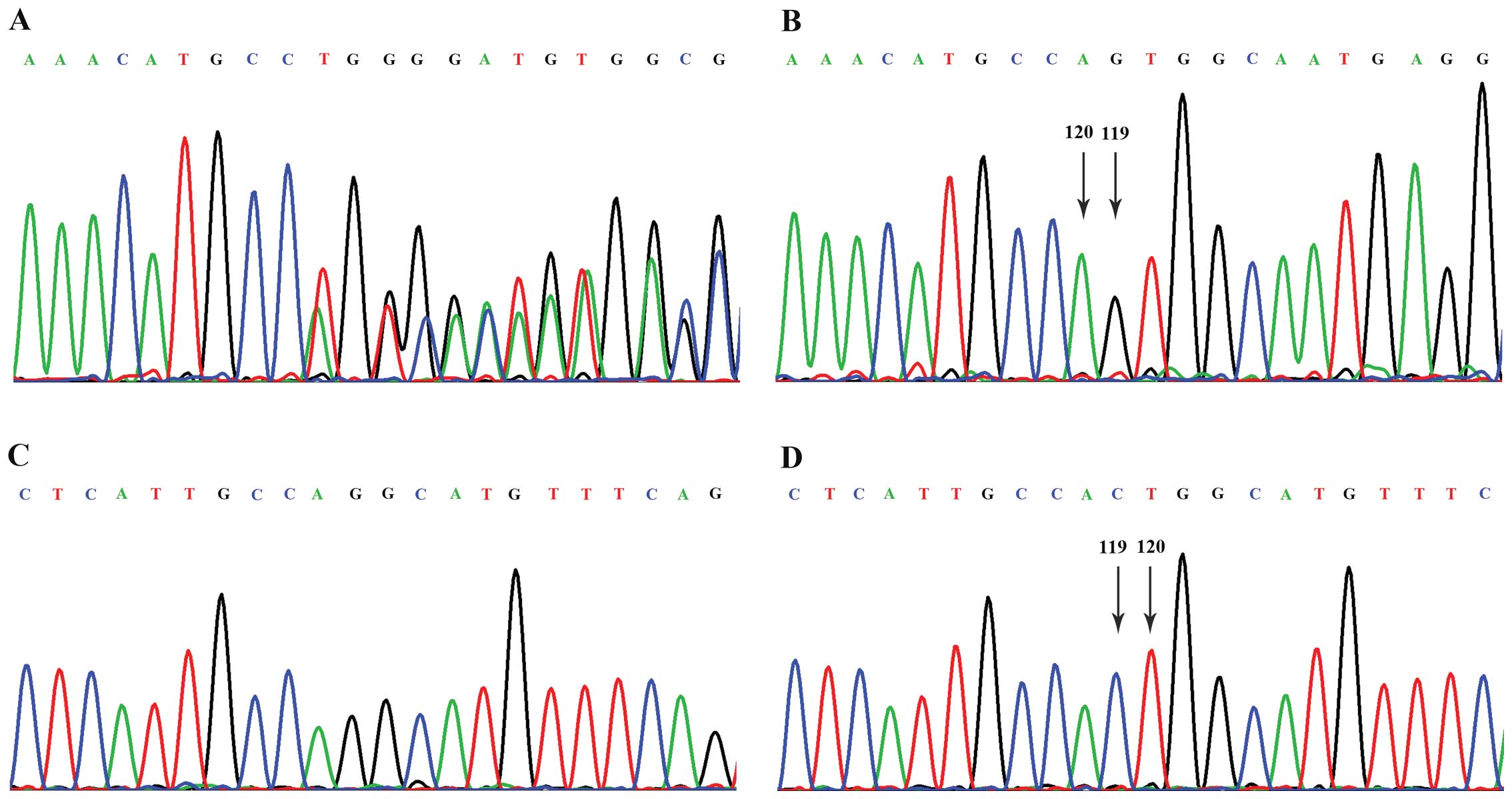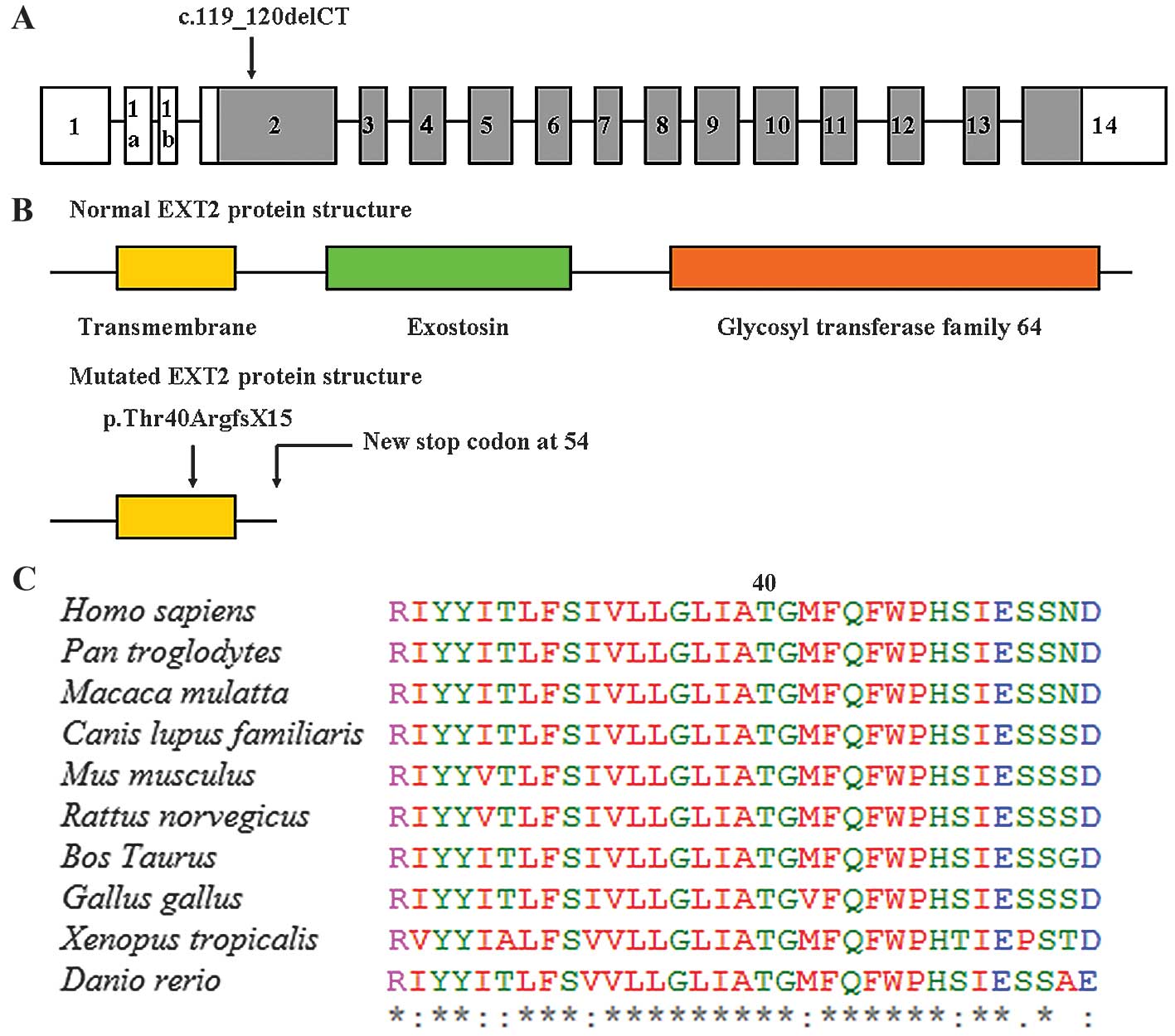Identification of a novel frameshift mutation of the EXT2 gene in a family with multiple osteochondroma
- Authors:
- Published online on: October 29, 2015 https://doi.org/10.3892/ol.2015.3844
- Pages: 105-110
-
Copyright: © Xia et al. This is an open access article distributed under the terms of Creative Commons Attribution License.
Abstract
Introduction
Multiple osteochondroma (MO; MIM #133700 and #133701), also known as multiple hereditary exostoses, is an autosomal dominant skeletal disorder with characteristic multiple cartilage-capped tumours (exostoses or osteochondromas) growing outward from the metaphyseal region of the long tubular bones. The estimated prevalence of MO has been recorded to range from 1/100 in a small Guam population (1) to 1.3/100,000 in a European population (2) and at least 1/50,000 in a Western population (3). Osteochondromas are a consequence of the superfluous proliferation of chondrocytes and bone growth at the juxta-epiphyseal regions of the long bones, and are the most frequently identified benign bone tumour. Osteochondromas are slow-growing during the first decades of life, growing in number and size until the closure of the growth plates upon skeletal maturation at the end of puberty. Characteristic features of MO consist of significant inter- and intra-familial phenotypic variability, including variability in the size and number of the osteochondromas, the location and number of the associated bones, and the degree of the deformity. Although benign, osteochondromas can result in a number of secondary complications, including compression of the blood vessels, tendons and nerves. Individuals with osteochondroma are often of short stature, with deformities leading to problems in functionality. The most serious secondary complication is the malignant transformation toward a secondary peripheral chondrosarcoma, which occurs in 0.5–5% of cases (4).
MO is a genetically heterogeneous disease. At least 2 loci have been isolated by linkage analysis and positional cloning: EXT1 (MIM #608177) maps to chromosome 8q24.11-q24.13, spans ~350 kb and is comprised of 11 exons (5), while EXT2 (MIM #608210) maps to chromosome 11p11-p11.2, spans almost 108 kb and is comprised of 16 exons (6). EXT1 and EXT2 belong to the putative tumour-suppressor EXT gene family, which also contains three homologous EXT-like (EXTL) genes: EXTL1, EXTL2 and EXTL3 (7–9). All EXT gene family members share a homologous carboxyl terminus and encode glycosyltransferases that are involved in heparin sulfate (HS) biosynthesis (10). A number of studies have investigated MO-causing mutations in a variety of populations (11–13). These data are being gathered in the Multiple Osteochondromas Mutation Database (http://medgen.ua.ac.be/LOVDv.2.0/). To date, >400 and 200 mutations have been identified in EXT1 and EXT2, respectively. The majority of the mutations (80%) are nonsense, frameshift and splice site mutations, which lead to the premature termination of translation, or are involved in the partial or total deletion of the gene (14).
The present study screened for mutations in the EXT1/EXT2 genes using polymerase chain reaction (PCR) and direct sequencing in three generations of a family with MO. A novel frameshift mutation, c.119_120delCT (p.Thr40ArgfsX15), was consequently identified in exon 2 of the EXT2 gene.
Patients and methods
Patients
Three generations of a MO family from Jilin, China, were investigated in the present study (Fig. 1). From the family, 8 members were affected with MO, including 2 deceased individuals. The proband (III-16) was a 28-year-old man suffering from multiple exostoses involving the bilateral proximal humeri, the left ulnar, the bilateral proximal and distal tibiae, the bilateral distal femurs and the right proximal femur (Fig. 2). On January 13, 2014, the proband underwent osteochondroma surgery for the right femur at Country Hospital of Fusong (Fusong, China) due to pain and functional limitations. At 15 days post-surgery (January 28, 2014), the proband suffered a subtrochanteric fracture of the right femur and was referred to the Second Hospital of Jilin University (Changchun, China), where internal fixation of the fracture site was performed.
Clinical data of each subject was recorded by nurse-administered questionnaires. Each participant underwent careful physical and/or radiographic examinations by two or more experienced experts at the Department of Orthopedics, The Second Hospital of Jilin University (Changchun, Jilin, China). MO was classified as at least 2 osteochondromas, arising from the lateral ends of the humeri, ulnae, femurs, tibiae, fibulae or knee joints. A group of 50 unrelated healthy subjects, matched for geographical ancestry, were included as controls. EDTA-anticoagulated peripheral blood (5 ml) was drawn from 10 family members (Table I) and from the 50 healthy controls. Written informed consent was obtained from all subjects or their respective guardians prior to their participation in the experimental protocol. This study was approved by the Ethics Review Committee of the Second Hospital of Jilin University.
Genetic analysis
Genomic DNA was extracted from peripheral blood leukocytes using the QIAamp DNA Blood Mini kit (Qiagen, Hilden, Germany) according to the manufacturer's protocols. All exons and flanking intronic regions of the EXT1 and EXT2 genes were amplified by PCR using the primers listed in Table II. The amplifications were performed to a final volume of 50 µl, containing 1 µl genomic DNA, 25 µl 2X Premix Taq™ (Takara Biotechnology Co., Ltd., Dalian, China), 1 µl of each primer and 22 µl sterilized distilled water. All PCR programs included an initial denaturation of 5 min at 95°C, followed by 35 cycles of 30 sec at 95°C, 45 sec at annealing temperature (Ta) and 30 sec at 72°C. Finally, an extension at 72°C was performed for 10 min. Ta was 60°C for all primer combinations, with the exception of primers for the amplification of overlapping regions of exon 1 of EXT1. For these primer combinations, Ta was set at 57°C for ex1–2 and ex1–3. Direct sequencing of the PCR products was performed using BigDye® Terminator v3.1 (Applied Biosystems, Foster City, CA, USA) with the ABI 3730 automated sequencer. Sequences generated from patients were compared with the published EXT1 and EXT2 reference sequences from the National Center for Biotechnology Information (http://www.ncbi.nlm.nih.gov/; GenBank accession nos. NM_000127.2 and NM_207122.1, respectively). When an insertion/deletion mutation was found, the amplified products with mutations were first ligated to a pMD-18T vector (Takara Biotechnology Co., Ltd.) and transformed into Escherichia coli. Next, sequencing was performed with plasmids extracted from E. coli using the AxyPrep Plasmid Miniprep kit (Axygen Biosciences, Union City, CA, USA). In addition, detected mutations were confirmed in another 50 unrelated healthy controls.
In silico analysis and homology study
When a mutation that had never been reported was found, the functional consequences of amino acid changes were predicted using the Mutation Taster software (http://www.mutationtaster.org). Regarding the homology study, ClustalW2 software (http://www.ebi.ac.uk/Tools/msa/clustalw2/) was used to compare the human EXT2 protein sequence (NP_997005.1) with the homologs from Pan troglodytes, Macaca mulatta, Mus musculus, Rattus norvegicus, Canis lupus familiaris, Bos taurus, Gallus gallus, Danio rerio and Xenopus (sequences acquired from http://www.ensembl.org/).
Results
Genetic analysis identifies a novel frameshift mutation (c.119_120delCT) in EXT2 as the causative mutation in the MO family
Following sequencing of all the exons and flanking intronic regions of the EXT1 and EXT2 genes, no mutations were detected in the EXT1 gene, but a heterozygous deletion of two nucleotides (CT) at c.119_120 in exon 2 of the EXT2 gene was found in the proband (Fig. 3). Subsequently, this variation was detected in all the 5 affected individuals (II-7, II-17, III-9, III-10 and III-18) in this pedigree by PCR and direct sequencing, and was not detected in any of the 4 unaffected family members (II-5, III-11, III-14 and III-17) or in the 50 healthy controls. Thus, this finding suggested that the novel c.119_120delCT frameshift mutation in the EXT2 gene was the causative mutation for MO in this family.
In silico analyses indicate the critical impact of the c.119_120delCT mutation on EXT2 function
The EXT2 gene consists of 16 exons, and the c.119_120delCT mutation was located in exon 2 (Fig. 4A). To understand the potential impact of the c.119_120delCT frameshift mutation on EXT2 function, in silico analyses were performed and the predicted result was disease-causing. The EXT2 protein is composed of 718 amino acids, with one transmembrane region (amino acids 26–46) and two critical domains: The exostosin domain (amino acids 100–380) and the glycosyltransferase family 64 domain (amino acids 456–701) (Fig. 4B). The c.119_120delCT frameshift mutation results in the substitute of amino acid Threonine by Arginine at position 40 and creates a premature translational termination signal at amino acid position 54 of the EXT2 protein (Fig. 4B). Compared with normal EXT2 protein, the mutated EXT2 protein lacks 665 amino acids at the C-terminus, including the two critical exostosin and glycosyltransferase family 64 domains. Thr40 is located in the transmembrane region, which is highly conserved across various vertebrate species (Fig. 4C), indicating its functional importance.
Discussion
EXT1 and EXT2 are tumour suppressor genes encoding for endoplasmic reticulum-localized type II transmembrane glycoproteins (15). EXT1 and EXT2 form a hetero-oligomeric complex in the Golgi apparatus that catalyses the alternative transfer of N-acetyl-glucosamine and D-glucuronic acid residues to the elongating HS glycosaminoglycan chain (16). This observation is consistent with the notion that inherited mutations in either of the two EXT genes could result in MO. HS and HS proteoglycans are known as regulators of the distribution and receptor binding of signalling molecule family members such as transforming growth factor-β, fibroblast growth factor, and Indian hedgehog (IHH) (17). Previously, studies showed that mutations in the EXT1/EXT2 genes impaired the biosynthesis of HS and that a decreased content of HS disturbs the IHH/parathyroid hormone-related peptide signalling pathway in MO; this disturbance leads to abnormal endochondral ossification resulting in exostoses formation (18,19).
EXT1 and EXT2 gene mutations have been reported to be involved in the pathogenesis of MO and are responsible for 70–95% of MO cases. EXT1 accounts for 56–78% of the MO families, whereas an EXT2 mutation is detected in 21–44% of cases (20). EXT1/EXT2 mutation analysis demonstrated that mutations in EXT1 are more common in the Caucasian population in North America and Europe. However, these associations were different in the Chinese population, where mutations in EXT2 were more common than EXT1 mutations (21). In the past 10 years, 67 Chinese families affected with MO and 10 spontaneous cases affected with MO have been screened for mutations in EXT1 or EXT2. Mutations in the EXT1 gene account for 37.7% (29/77) of the patients, whereas EXT2 mutations account for 44.2% (34/77), which is higher than that of EXT1. Based on all the aforementioned data, EXT2 mutations may be responsible for more cases of MO in the Chinese population. EXT2 mutations tend to be concentrated in the first two-thirds of the coding region, and mutations may occur more commonly in exon 2 compared with other exons of EXT2, whereas mutations in EXT1 are reported to be scattered throughout the complete gene.
In the present study, a large family with MO was investigated and a sequence analysis was performed of the entire coding regions of EXT1 and EXT2 for the proband (III-16). A heterozygous deletion of two nucleotides (CT) was found at c.119_120 in exon 2 of EXT2 in the proband, and this variation was also present in all the other 5 affected patients (II-7, II-17, III-9, III-10 and III-18) from this pedigree, but was not detected in any of the 4 unaffected family members (II-5, III-11, III-14 and III-17) or in the 50 healthy controls. This mutation (c.119_120delCT; p.Thr40ArgfsX15) results in a frameshift mutation starting from amino acid position 40 and introduces a premature termination signal at amino acid 54, which leads to the production of a truncated EXT2 protein with only 53 amino acids, 665 amino acids shorter than the normal EXT2 protein. Furthermore, the c.119_120delCT mutation was located in the transmembrane region of the EXT2 protein, the mutated EXT2 protein lacking 665 amino acids at the C-terminus, which included the two critical exostosin and glycosyltransferase family 64 domains.
In conclusion, the present study identified a novel deleterious frameshift mutation, c.119_120delCT (p.Thr40ArgfsX15), in the transmembrane region of the EXT2 gene from a large MO family. This study is useful for extending the known mutational spectrum of EXT2, for understanding the genetic basis of MO in the patients studied, and for further application of mutation screening in the genetic counseling and subsequent prenatal diagnosis of this family.
Acknowledgements
The authors would like to thank all the study participants for their interest and cooperation in this study.
References
|
Krooth RS, MacKlin MT and Hilbish TF: Diaphysial aclasis (multiple exostoses) on Guam. Am J Hum Genet. 13:340–347. 1961.PubMed/NCBI | |
|
Hennekam RC: Hereditary multiple exostoses. J Med Genet. 28:262–266. 1991. View Article : Google Scholar : PubMed/NCBI | |
|
Schmale GA, Conrad EU III and Raskind WH: The natural history of hereditary multiple exostoses. J Bone Joint Surg Am. 76:986–992. 1994.PubMed/NCBI | |
|
Bovée JV: Multiple osteochondromas. Orphanet J Rare Dis. 3:32008. View Article : Google Scholar : PubMed/NCBI | |
|
Lüdecke HJ, Ahn J, Lin X, Hill A, Wagner MJ, Schomburg L, Horsthemke B and Wells DE: Genomic organization and promoter structure of the human EXT1 gene. Genomics. 40:351–354. 1997. View Article : Google Scholar : PubMed/NCBI | |
|
Clines GA, Ashley JA, Shah S and Lovett M: The structure of the human multiple exostoses 2 gene and characterization of homologs in mouse and Caenorhabditis elegans. Genome Res. 7:359–367. 1997.PubMed/NCBI | |
|
Wise CA, Clines GA, Massa H, Trask BJ and Lovett M: Identification and localization of the gene for EXTL, a third member of the multiple exostoses gene family. Genome Res. 7:10–16. 1997. View Article : Google Scholar : PubMed/NCBI | |
|
Wuyts W, Van Hul W, Hendrickx J, Speleman F, Wauters J, De Boulle K, Van Roy N, Van Agtmael T, Bossuyt P and Willems PJ: Identification and characterization of a novel member of the EXT gene family, EXTL2. Eur J Hum Genet. 5:382–389. 1997.PubMed/NCBI | |
|
Van Hul W, Wuyts W, Hendrickx J, Speleman F, Wauters J, De Boulle K, Van Roy N, Bossuyt P and Willems PJ: Identification of a third EXT-like gene (EXTL3) belonging to the EXT gene family. Genomics. 47:230–237. 1998. View Article : Google Scholar : PubMed/NCBI | |
|
Senay C, Lind T, Muguruma K, Tone Y, Kitagawa H, Sugahara K, Lidholt K, Lindahl U and Kusche-Gullberg M: The EXT1/EXT2 tumor suppressors: Catalytic activities and role in heparan sulfate biosynthesis. EMBO Rep. 1:282–286. 2000. View Article : Google Scholar : PubMed/NCBI | |
|
Lonie L, Porter DE, Fraser M, Cole T, Wise C, Yates L, Wakeling E, Blair E, Morava E, Monaco AP and Ragoussis J: Determination of the mutation spectrum of the EXT1/EXT2 genes in British Caucasian patients with multiple osteochondromas, and exclusion of six candidate genes in EXT negative cases. Hum Mutat. 27:11602006. View Article : Google Scholar : PubMed/NCBI | |
|
Ciavarella M, Coco M, Baorda F, Stanziale P, Chetta M, Bisceglia L, Palumbo P, Bengala M, Raiteri P, Silengo M, et al: 20 novel point mutations and one large deletion in EXT1 and EXT2 genes: Report of diagnostic screening in a large Italian cohort of patients affected by hereditary multiple exostosis. Gene. 515:339–348. 2013. View Article : Google Scholar : PubMed/NCBI | |
|
Delgado MA, Martinez-Domenech G, Sarrión P, Urreizti R, Zecchini L, Robledo HH, Segura F, de Kremer RD, Balcells S, Grinberg D and Asteggiano CG: A broad spectrum of genomic changes in latinamerican patients with EXT1/EXT2-CDG. Sci Rep. 4:64072014. View Article : Google Scholar : PubMed/NCBI | |
|
Wuyts W and Van Hul W: Molecular basis of multiple exostoses: Mutations in the EXT1 and EXT2 genes. Hum Mutat. 15:220–227. 2000. View Article : Google Scholar : PubMed/NCBI | |
|
Lind T, Tufaro F, McCormick C, Lindahl U and Lidholt K: The putative tumor suppressors EXT1 and EXT2 are glycosyltransferases required for the biosynthesis of heparan sulfate. J Biol Chem. 273:26265–26268. 1998. View Article : Google Scholar : PubMed/NCBI | |
|
McCormick C, Duncan G, Goutsos KT and Tufaro F: The putative tumor suppressors EXT1 and EXT2 form a stable complex that accumulates in the Golgi apparatus and catalyzes the synthesis of heparan sulfate. Proc Natl Acad Sci USA. 97:668–673. 2000. View Article : Google Scholar : PubMed/NCBI | |
|
Esko JD and Lindahl U: Molecular diversity of heparan sulfate. J Clin Invest. 108:169–173. 2001. View Article : Google Scholar : PubMed/NCBI | |
|
Zak BM, Crawford BE and Esko JD: Hereditary multiple exostoses and heparan sulfate polymerization. Biochim Biophys Acta. 1573:346–355. 2002. View Article : Google Scholar : PubMed/NCBI | |
|
Koziel L, Kunath M, Kelly OG and Vortkamp A: Ext1-dependent heparan sulfate regulates the range of Ihh signaling during endochondral ossification. Dev Cell. 6:801–813. 2004. View Article : Google Scholar : PubMed/NCBI | |
|
Jennes I, Pedrini E, Zuntini M, Mordenti M, Balkassmi S, Asteggiano CG, Casey B, Bakker B, Sangiorgi L and Wuyts W: Multiple osteochondromas: Mutation update and description of the multiple osteochondromas mutation database (MOdb). Hum Mutat. 30:1620–1627. 2009. View Article : Google Scholar : PubMed/NCBI | |
|
Xu L, Xia J, Jiang H, Zhou J, Li H, Wang D, Pan Q, Long Z, Fan C and Deng HX: Mutation analysis of hereditary multiple exostoses in the Chinese. Hum Genet. 105:45–50. 1999. View Article : Google Scholar : PubMed/NCBI |













